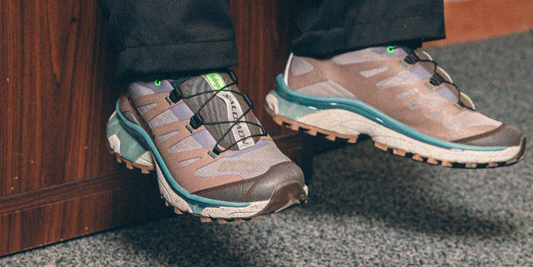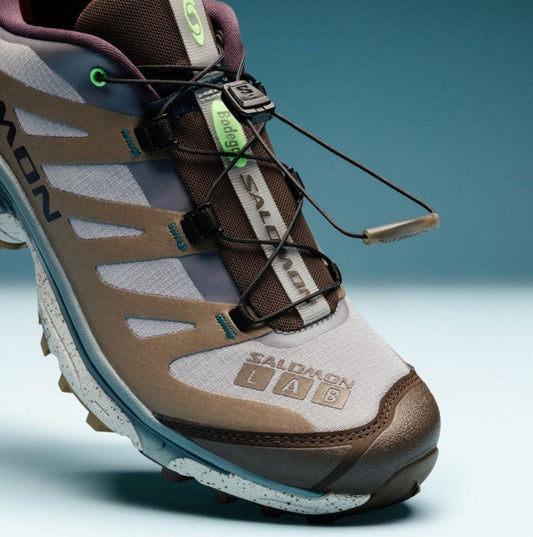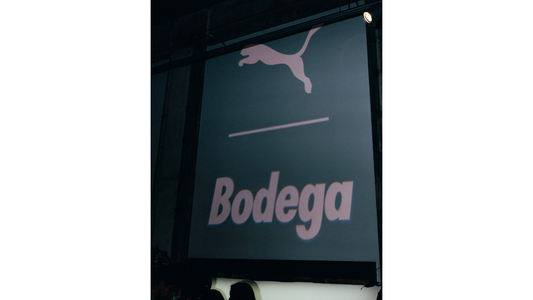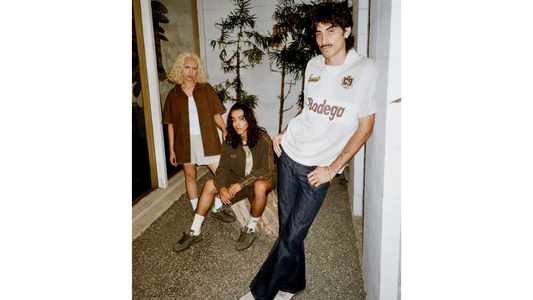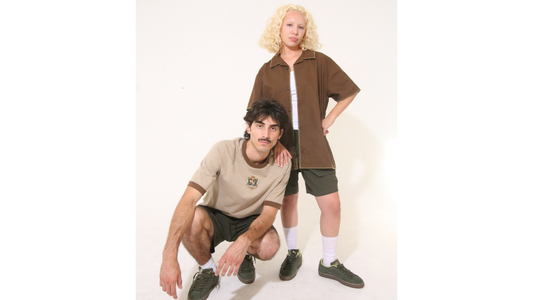It wasn’t just North American sports that experienced a merchandising boom in the 1990s.
The world’s most popular sport also underwent a massive upswing in sales. After our last editorial took you on a tour of the best and worst identity changes Stateside during the latter half of the ‘80s and the 90s, we now take a closer look at the design of the era’s soccer jerseys.
For the uninitiated, one thing to keep in mind about soccer clubs is that the crest and colors are the permanent markers of identity. The shirt itself is open to interpretation, although changes were less common and much less radical in the days before the commercial aspect of fandom took off.
For decades, changes that occurred in soccer jerseys were primarily physical. As textile technology progressed, old fashioned, heavy cotton gave way to lighter, synthetic fabrics, shirts and shorts got longer or shorter, tighter or baggier, in accordance with the day’s fashions, but there were precious few alterations that would have been purely aesthetic. For a long time, even manufacturer logos didn’t appear on shirts, as they were considered a) advertising and b) a distraction from the club crest. As far as soccer jersey design is concerned, the modern era began in the 1970s to 1980s transition, when shirt sponsors and manufacturer logos became permanent fixtures.
In the first half of the 1980s, designs were fairly staid. Pinstripes were the most common embellishment, while the major brands of the era each had their own signature styles. Three sleeve stripes for adidas, Umbro’s double diamond logo taping, Puma’s one large stripe to sleeves and shoulders, and so on. The first hints that change was in the air came in the mid-‘80s. At the 1984 European Championship, adidas introduced two memorable, completely unique designs. Belgium’s red primary shirts featured a horizontal strip of argyle, which looked like it had been borrowed from the tennis court, in the colors of the Belgian flag, and the French team’s blue primary shirts sported a single, wide horizontal stripe of red, and a sequence of narrower white stripes. As Euro 84 marked France’s first international tournament win, the shirt became the standard for future designs, for as long as the federation was contracted with adidas. The wildest shirts of the time came courtesy of Danish sportswear firm Hummel. Stunning efforts for the likes of Denmark’s national team, Tottenham Hotspur, Aston Villa and Coventry City presciently reflected the future of soccer shirt design. At the time though, they were still the exception rather than the rule.
An exhaustive history of the ins and outs of shirt design could likely fill an entire book, which is space we don’t have here. For expediency and clarity’s sake, we’ve chosen to highlight a selection of memorable designs that exemplify the twists and turns of the era. This is not a best/worst, or a complete chronicle, so there are a lot of famous shirts that aren’t here. We look forward to hearing about them on the social media posts.
1986-1989 The First Mutations:
Hummel - Denmark national team 1986 - As mentioned above, Danish sportswear firm Hummel were ahead of the curve by a couple of years. When the most radical embellishments to the majority of designs were pinstripes, Hummel dropped a half solid, half pinstripe design that made liberal use of their signature chevron logo on top of it. There was certainly nothing else like it at the 1986 World Cup in Mexico, where it proved as noteworthy as the Danish Dynamite side that tore through a group containing West Germany, Uruguay and Scotland, before being shredded by Spain’s lethal counterattacking in the Round of 16. Perhaps an appropriate conclusion for a design that admittedly had as many detractors, who just weren’t ready for its radicalism, as it did supporters.
adidas – West Germany national team 1988 - Everyone thinks this shirt debuted at the 1990 World Cup, most likely because West Germany ended up winning it, but it actually came out for West Germany’s 1988 European Championship campaign. The national team shirt had been black and white since, forever. The addition of an angular, stylized rippling flag design in the national black, red and gold colors was as modern as it was unexpected. After spending the entire 1980s as the arch-villains of the international game, the new design also helped usher in a new era, with players like Jurgen Klinsmann, Rudi Voller and Andi Moller who, if not exactly beloved, were at least grudgingly admired by neutrals. Also, Lothar Matthaus was there.
adidas – Netherands and USSR national teams 1988 - The German flag design wasn’t the only striking debut at Euro 88. The two teams that would end up contesting the final both sported an all-over geometric block design, with subtle gradient effect, creating a slightly lightened version of the traditional solid orange and red worn by the respective nations. The geometric design proved fitting for two teams known for employing tactical intelligence and precision teamwork to dazzling effect. Fun fact, the design would also feature on West Germany’s change shirt at the 1990 World Cup.
1990-92 The Coming Out Party:
Puma – Austria national team 1990 - With the exception of a 1978 World Cup win over defending champions and arch-enemy West Germany, Austria’s greatest international soccer moments predate television. The 1990 World Cup was no exception. Losses against Italy and Czechoslovakia and a win against the US meant a quick, group stage exit. Unfortunate, as far as shirts go, because Austria’s design for this tournament is a forgotten gem. A prominent, twisting ribbon effect added a modern, fluid look, which distinguished itself from the blocks and angles designs of competitor adidas, to the standard white shirts with black trim.
adidas – Arsenal 1991-92: At the start of the decade, three of England’s biggest clubs, Arsenal, Liverpool and Manchester United were contracted to adidas, who utilized the massive presence of these clubs to showcase some of their most daring designs to date. The Liverpool and Manchester United shirts were interesting. Arsenal’s was iconic. Arsenal’s traditional change shirt colors are yellow and blue. The blue gradient zig-zag design of the ‘bruised banana’ employed these to such a unique and powerful effect, that even committed Arsenal haters (not an especially small population) could not help but admire it for pure aesthetic value. In 1991, the replica shirt market was still emerging, making the bruised banana one of the very first shirts to be an essential piece of fashion.
adidas Olympique Marseille 1991-92 - Another major development, courtesy of the three stripes took place in 1991 that truly altered the design landscape forever. With the introduction of the Equipment range, and the new triangular stripes logo, old-school simplicity was well and truly done for. The shirts produced under the new Equipment banner were templates, all of which featured novel and prominent applications of the equipment logo, instead of the old three stripes at the sleeves. Many major club and international sides were decked out in these designs, but perhaps the greatest hour of glory for the first run of Equipment shirts was achieved by Olympique Marseille. The over the shoulder Equipment stripes design introduced in 1991-92, was worn during Marseille’s first European Cup triumph the following season.
Umbro – Tottenham Hotspur 1991-92 - Masters of the sublimated shadow design and woven jacquard, Umbro have a long tradition in the game, and as an England based brand, were the final word in soccer shirts for many years in the game’s birthplace. Still, they always showed an enthusiasm for embracing the current times. When they took over Tottenham’s kit from Hummel in 1991, they made an immediate splash by reintroducing baggy shorts, after years of short and tight as the standard. The first away shirt they produced for Spurs was so popular, it lasted for three full seasons, with a fourth as a third kit. Out of their original, 1991 output for the North London club, Umbro’s third kit was the most forward looking. A light blue base housed a series of thin, vertical lines on the top third of the shirt, where SPURS was spelled out, while the fine lines trailed off into thin, vertical stripes that continued down the rest of the shirt. The motif continued onto half and half shorts, with vertical stripes on one side and the SPURS text on the other.
Lotto – Fiorentina 1991-92 - Longtime soccer fans will be familiar with the Northern Italian sportswear firm who supplied kits to the likes of AC Milan, the Dutch national team, and Juventus, among many others, over the years. (Fun fact: at the 1994 World Cup, there were three teams wearing Lotto, and zero wearing Nike.) Leaving aside the clichés about everything in Italy being unfathomably chic at all times, the top clubs in Italy generally maintained a sober aesthetic, steeped in tradition. Granted, this 1991 affair for Fiorentina was an away shirt, not the primary shirt, but its combination of polo collar, pinstripes, sleeve branding, and a massive, explosive geometric graphic housing Lotto logos across the front, made it the most outré display among Italy’s elite at the time.
1993-1997: No Limits
Nike – Paris Saint Germain 1993-94 – It’s hard to imagine Nike as a minor player anywhere, but during the first half of the ‘90s, their presence in the global game was limited. This discrepancy with Nike’s status everywhere else actually lent the clubs they did produce kits for an extra, intangible cool factor. One of Nike’s longest relationships in soccer is with Paris Saint-Germain. PSG may be flush with cash and power in 2020, but in the ‘90s, they had a reputation a club whose glamourous image wasn’t backed up with trophies. The middle of the decade was a high point, with a Champions League semi-final run and a Cup Winners’ Cup triumph. The 1993-94 PSG shirt saw the traditional, thick red stripe in the center of PSG’s shirt expanded, with a series of decreasingly thick, extra vertical lines. This sense of modernizing long established conventions was just a taste of what Nike had in store for soccer.
adidas – U.S. national team 1994 – Critics scoffed at the decision to name the United States as the host of the 1994 World Cup, but the event was a major success on all fronts, particularly when the often thrilling onfield play contrasted with the torpid style of Italia ’90. The ‘World Cup, American style’ sense of novelty and spectacle was reflected in adidas’ output for the U.S. national team. Throwing out the playbook doesn’t even begin to do justice to the acid washed denim design, with front and back star spangled graphics. Only the stodgiest of traditionalists could fail to be won over by audacity of this design. The away shirt, a flag waving take on a more standard vertical stripe look, wasn’t too shabby either.
Nike – Arsenal 1994-95 – To be clear, Paris Saint Germain and Borussia Dortmund, Nike’s biggest existing contracts to start 1994, were major, international clubs, the Swoosh touching town in the Premier League, however, marked a major event in the branding landscape of soccer. Their first effort for North London giants Arsenal wasn’t the radical, out of left field change seen in other entries. The traditional red shirt with white sleeves Arsenal template was adhered to, but with Nike’s signature flair. A shadow print design featuring a vertical zig-zag and the ‘Gunners’ nickname down the length of the shirt, the addition of Arsenal in gothic script at the back hem, only seen when untucked, and horizontally hooped socks achieved the impossible. They made a club with the reputation as the most boring and miserable in the entire history of England, cool.
Umbro – Celtic/Manchester United/Ajax Amsterdam 1995-96/1996-97 – There was definitely an Umbro house style that ensured any team kitted out in the double diamonds was stylish, even if they were relegation candidates. By the middle of the decade, the standard jacquard, shadow print graphics Umbro design hit peak form. It’s impossible to highlight them all, but the Manchester United shirt that featured Old Trafford as a backdrop, the Celtic shirt that backed the green and white hoops with Gaelic style, “Celtic F.C.” script, and the Ajax Amsterdam shirt featuring an Amsterdam landscape serve as particularly high profile examples.
adidas – Newcastle United 1995-96 – The adidas Equipment range certainly carried the three stripes’ legacy of performance innovation into a new decade, but it didn’t have quite the same pop cultural resonance as old-school adidas gear. As the replica jersey market took off, adidas made a subtle, cosmetic branding change, switching to a text only logo, first seen on the brand’s 1994 World Cup designs. This switch was perfectly timed for a mini-old school revival that took place in the mid-‘90s. Some classic elements made their way back onto the field, with one of the classiest examples being the rounded, button up collar take on the black and white stripes of Newcastle. Even the painful memories of faltered title campaigns can’t dim the fondness for the cavalier attacking side of Shearer, Ginola, Ferdinand and Asprilla.
Kappa – Juventus 1995-96 – You could accuse Juventus of a lot of things, but lacking self-confidence will never be one of them. While the black and white stripes of la vecchia signora are an imposing constant, Juve’s mid-‘90s away shirt was an especially loud declaration of superiority. Outfitted by fellow Turin institution Kappa, a world class Juventus side ran out in a blue shirt with oversized, yellow stars at the shoulders. Coincidentally, the UEFA Champions League just so happened to sport star-centric branding. Appropriately enough, this was the shirt worn when Juventus dethroned Ajax in the 1996 Champions League final.
Reebok – Liverpool 1996-97 – The old-school revival of the mid-‘90s was especially apt for a club that often found itself looking back to the good old days, Liverpool. In Reebok’s first season as kit suppliers to the club, retro influences abounded. (Star players even dressed like the Beatles in the promotional campaign.) The away shirt, though, stood out as one of the finest examples of the form produced anywhere. Old-school elements, a rounded collar, and Liverpool crest housed within an oval badge, combined with a contemporary shadow print and trendy ecru color.
Nike PSV Eindhoven 1996-97 – There was nothing retro about Nike’s interpretation of PSV Eindhoven’s red and white stripes. One of the most traditional possible looks, vertical stripes, was reoriented into a futuristic, curved design, including a stripe that wrapped from the torso, all the way up the sleeves to the collar. Like so many of PSV’s sides, this shirt was criminally underrated outside of the Netherlands.
A non-traditional detour: MLS and the J-League - It’s impossible to not mention the J-League and MLS in a retrospective of ‘90s jersey designs, but it’s almost impossible to place these newly formed entities in the same context as established leagues. It might be simplest to say that, unburdened by notions of tradition, the likes of the Kansas City Wiz, San Jose Clash, Nagoya Grampus Eight, Gamba Osaka, and everyone else in these two leagues, made the ‘90s that much more colorful and fun.
1997-1999 Looking towards the future:
adidas – Feyenoord 1997-98 – Eventually, adidas was comfortable placing their standard stripe design on shirts again, although, not always on the sleeves. The half and half shirt of Dutch power Feyenoord allowed for an especially unique three stripes application, as they provided the border between the red and white sections of the shirt.
Kappa – Manchester City 1997-98 – Not every radical change entailed crazy, all-over patterns. When Kappa took over as Man City’s kit supplier, they swapped out the club’s traditional sky blue for a deeper, ‘laser’ blue, with a new crest for good measure, completing a modernizing overhaul. Having been relegated at the end of the 95-96 season, it wasn’t like City had a lot to celebrate on the field at the time. Although, the Kappa update didn’t immediately improve fortunes either; only a playoff against Gillingham, probably this shirt’s most famous moment, prevented City from dropping into the third division.
ABA Sport – Mexico national team 1998 – The manufacturers may not be a well known name, but their best known creation is unmistakable and unforgotten. Mexico took the field at the 1998 World Cup in an all-over Aztec design. One of those instances in which the picture speaks for itself.
ASICS – Japan national team 1998 – As the ‘90s drew to a close, the shadow pattern as a standard part of shirt design was on its way out, but it was still in heavy enough rotation to be given some memorable treatments at the 1998 World Cup. Japan’s first ever trip to the World Cup ended terribly in terms of performance, three games, three losses, but a traditional Japanese flame motif graphic at the sleeves and as a shadow print made the Samurai Blue one of the best dressed squads at least.
Nike – Barcelona 1998-99 – Barcelona constituted another massive “get” for Nike, so it made perfect sense to lead the charge into a new style with the shirt of the institution that bills itself as more than a club. Ornamental details fell by the wayside, with a matte, metallic grey shirt with the blaugrana colors running up the sides of the torso to the undersides of the sleeves. It was sleek, fresh and forward looking, like the team’s style of play (until Van Gaal’s tenure went sideways). As the Barcelona shirt was, at that time, still admirably free of advertising, the modernity stuck out even more. The new millennium had arrived.



